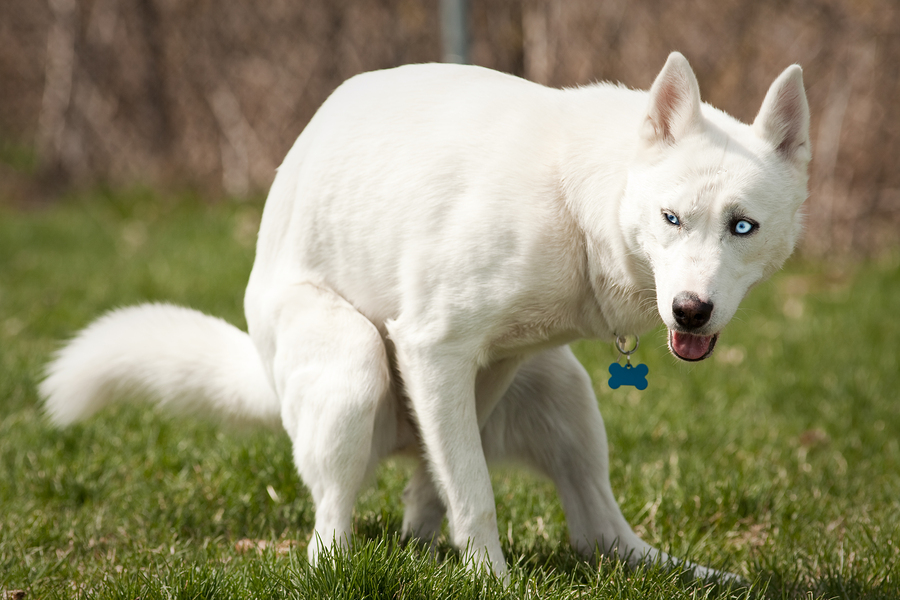Everyone who shares a home with a dog deals with poop on a daily basis. While it may not be the most appealing topic, learning about your dog’s “output” offers important insight into his health.
Not only his food, but also your dog’s environment and emotional state, affects how his body works. Fear, anxiety, and stress not only affect a dog’s behavior, but can also disrupt digestion. That in turn affects poop.
Recognizing healthy elimination helps alert pet owners to abnormal eliminations. That way, when necessary, you can get your dog prompt veterinary care to diagnose and treat problems.
Healthy Dog Poop
The consistency of feces varies a bit depending on diet. In general, your dog’s poop should be chocolate-brown, with a rather firm consistency, like stiff bread dough. It also should look like small logs, with intermittent fissures that easily split apart. There shouldn’t be any “extra” matter sticking out of or coating the feces. Normal dog poop has an earthy but relatively mild aroma.
Pet parents following poop-scooping rules recognize when something looks, smells, or “feels” off when they pick up dog waste. To check for abnormal dog poop, be alert to texture, color, content, and smell. Here’s what to watch for.
What’s in Poop
Normal feces won’t contain anything but uniform digested matter, with an overall consistency. If you see recognizable (or even mysterious) content mixed in feces, get it checked out.
Parasites: Visible worms moving in your dog’s fresh deposit point to intestinal parasites. Tapeworm segments look like tiny white inchworms or dried grains of rice. Long white spaghetti-like strings point to roundworms, typical in puppies.
Hair: During shedding and flea season, some dogs swallow wads of fur when they chew themselves to relieve itchy aggravations. This could point to allergies, skin conditions, or other issues your veterinarian should address.
Foreign matter: Dogs swallow all kinds of things they shouldn’t. Most small undigestible material passes out of the system with poop. You may see grass, rocks, parts of toys, or cloth (dogs love to eat socks!). The danger lingers if not all material passes, and sharp objects can damage the gut. It’s always best to check with your veterinarian if you see something that doesn’t belong in the dog’s poop.
Mucus: There shouldn’t be any mucus in normal stool. That can be indicate large bowel irritation. It often happens with diarrhea, which should be checked by your veterinarian.
Consistency Matters
Abnormal dog poop consistency varies from liquid to pudding-like consistency. It can go the other direction, too, with hard, stone-like feces that can result in constipation and blockage. Liquid diarrhea poses dehydration dangers for dogs, especially youngsters.
Any time diarrhea is accompanied by vomiting, severe pain, fever, appetite loss, or lethargy, see the veterinarian immediately. An abnormal strong foul smell also needs attention.
Poop Color Score
You already know that normal poop looks like Tootsie Rolls or chocolate logs. Here are examples of problem poop colors:
Black or maroon (tar-like consistency): This indicates digested blood, probably from the stomach or small intestine.
Red streaks: Bright red blood probably comes from the lower intestinal tract, or from irritated anal glands.
Red/bloody diarrhea: This has many potential causes, from internal injury to possible viral infection, such as coronavirus (this is not the same novel coronavirus causing COVID-19 in humans) or parvovirus. Bloody stool from parvovirus has a distinctive foul smell.
Pink or Purple: Especially if pink poop looks like jam, it could be a sign of life-threatening hemorrhagic gastroenteritis (HGE). Get your dog to the emergency clinic right away.
Green: Green stool may indicate rapid bowel transit—food moves too quickly and normal bile (from the liver) has no time to be normally absorbed. It may also be due to diet (eating grass or green-colored treats).
Yellow or orange: Yellow or orange poop could mean problems with the liver, pancreas, or gallbladder. Sometimes the orange color could result from your dog eating a lot of raw carrots. Yellowish puddinglike poop with a distinctive foul smell also may be associated with distemper.
White or gray: Pale stools may indicate problems with the dog’s liver or gallbladder.
This article was reviewed/edited by board-certified veterinary behaviorist Dr. Kenneth Martin and/or veterinary technician specialist in behavior Debbie Martin, LVT.








